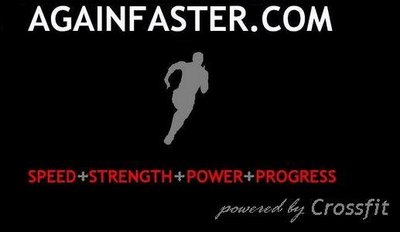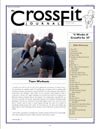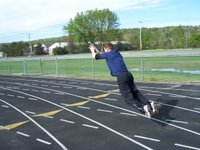Mastering the Split Jerk

Few exercises possess the beauty and violence of action inherent in the split jerk. Executed correctly, this lift allows superhuman loads to be boosted overhead, placing it in the upper echelon of effective speed and power movements.
Like the snatch and the clean, it is incredibly difficult. Proper execution demands incessant practice and an unreasonable willingness to drop under hundreds of pounds of earthbound iron. At Crossfit Boston, we dedicate hours each week to practicing the split jerk, helping athletes overcome their counterproductive inclinations toward self-preservation.
The split jerk has three phases: the dip and drive, the catch, and the recovery. Problems can arise in any or all of these phases, and must be dealt with for the full potential of the movement to be realized.
The dip and drive phase is crucial to imparting momentum and elevation on the bar. Without this momentum, the catch could not occur.
With the barbell in the rack position, the athlete bends the knees to a quarter-squat, keeping the torso vertical. Quickly reversing direction, he snaps the hips open and drives upward on the barbell. This sends the barbell skyward, the distance it travels inversely related to its weight. At its apex, the barbell is momentarily weightless.
During this first phase, there are several critical points. The torso must be oriented vertically the entire time, and the feet should be directly under the hips. Any deviation from these positions will reduce the force transmitted to the barbell, and may invite injury. It is very rare that a trainee will be unable to achieve either of these positions, as the newbie’s ever-present lack of hamstring flexibility has little bearing on torso orientation during a quarter-squat. Simply coach the correct positions, and move on.
The most pervasive flaw among beginning split jerkers is a slow dip, especially when the weight starts to get heavy. They’ll descend at a rate that makes molasses look fast, and then attempt to drive the weight from a near standstill. This kills the stretch reflex coming out of the bottom, and unnecessarily limits the amount of weight that can be lifted. The stretch reflex should be harnessed and utilized through a rapid descent and reversal.
I typically coach my athletes to execute the dip and the drive at the same speed, and then I tell them they’re doing it too slow, regardless of the outcome. I want it in their heads that speed is paramount.
Full execution of the drive can be a problem, especially if an athlete becomes preoccupied with the subsequent descent into the catch. This is relatively rare, but hard to remedy. If you see this occurring in your own performance, use a light weight and eliminate the post-drive descent until you’re confident that you’re reaching full extension on the drive.
Without a solid catch, the lift is over. As the barbell moves upward from the drive, the athlete reverses direction, taking advantage of the momentary weightlessness of the load to push himself under the barbell. Simultaneously, his legs split front and back into a modified lunge, and the arms come to full extension. The head and chest thrust through the arms, and the athlete lands, weight locked out overhead.
The typical mechanical flaws that present during the catch are easy to correct. Most often, an athlete will fail to thrust the head and chest forward, causing a misalignment between his center of gravity and that of the barbell, making the weight very hard to control. I cue the correct movement by telling the athlete to push his chin toward the wall.
He may also fail to lockout the rear leg, introducing unnecessary slack into the system, or place the rear foot flat on the platform, compromising the depth of the lunge and therefore the amount of weight that can be successfully locked out. Correcting these flaws will take some drilling. Instruct the athlete to lock out the back knee and keep the heel off the platform. Also, coach him into the deepest lunge possible with correct mechanics. As a general rule, the lower he goes, the more weight he’ll be able to jerk. Ensure that the feet are at a tenable width—twelve and six are not good positions for stability.
Crossfit’s legendary Olympic Weightlifting Coach Mike Burgener has a simple correction for this flaw: place a piece of PVC pipe between the athlete’s feet at the outset. No one wants to land on a round pipe, and proper width will result.
The majority of difficulties with the catch phase are mental rather than physical. Understandably, beginning split jerkers have difficulty accepting the dangers of dropping underneath a heavy barbell. Surrendering their connection with the platform and splitting the feet fore and aft is alien and seemingly suicidal, and no amount of talking will overcome this fear. Beginners must learn to feel the movement in a penalty-free environment. Grab a broomstick and practice until the catch is automatic, and gradually add weight over the course of a few weeks.
The recovery is the final phase of the split jerk. The athlete must return to standing, feet side-by-side, with the weight locked out overhead. Anything else and the entire lift is red-lighted—dip, drive, catch and all.
During the recovery, the barbell stays in one place. The front foot slides to a position directly below the barbell, followed by the rear foot doing the same. This sequence is imperative to success. Excessive movement of either foot will irreparably change the combined center of gravity of the athlete and the barbell, support will fail, and the weight will come crashing down. The precariousness of the recovery is amplified by heavier weights, where the slightest misstep will result in failure.
Unfortunately for the coach, lighter weights will allow the athlete make the recovery with terrible mechanics. The rear leg may move first, sometimes all the way to the final recovery position, without a fatal loss of control. This is only possible under light weight, where the athlete’s strength is sufficient to overcome the rapidly changing combined center of gravity. More than any other cue, I find myself repeating, “Front foot, back foot” over and over again. Improper recovery should be quashed early on before it becomes habit, and you find yourself with an athlete who can’t stand up without dropping the bar.
The split jerk is an incredibly fast movement—all three phases are over within a few seconds, and success demands speed. Correct mechanics are the foundation on which this speed is built, and should be drilled to perfection.
One last thought: Sometimes everything goes wrong. Make your lift anyway!
Go faster!
Picture of Coach and Sage Burgener, mid-split jerk, courtesy of Crossfit.com.

Few exercises possess the beauty and violence of action inherent in the split jerk. Executed correctly, this lift allows superhuman loads to be boosted overhead, placing it in the upper echelon of effective speed and power movements.
Like the snatch and the clean, it is incredibly difficult. Proper execution demands incessant practice and an unreasonable willingness to drop under hundreds of pounds of earthbound iron. At Crossfit Boston, we dedicate hours each week to practicing the split jerk, helping athletes overcome their counterproductive inclinations toward self-preservation.
The split jerk has three phases: the dip and drive, the catch, and the recovery. Problems can arise in any or all of these phases, and must be dealt with for the full potential of the movement to be realized.
The dip and drive phase is crucial to imparting momentum and elevation on the bar. Without this momentum, the catch could not occur.
With the barbell in the rack position, the athlete bends the knees to a quarter-squat, keeping the torso vertical. Quickly reversing direction, he snaps the hips open and drives upward on the barbell. This sends the barbell skyward, the distance it travels inversely related to its weight. At its apex, the barbell is momentarily weightless.
During this first phase, there are several critical points. The torso must be oriented vertically the entire time, and the feet should be directly under the hips. Any deviation from these positions will reduce the force transmitted to the barbell, and may invite injury. It is very rare that a trainee will be unable to achieve either of these positions, as the newbie’s ever-present lack of hamstring flexibility has little bearing on torso orientation during a quarter-squat. Simply coach the correct positions, and move on.
The most pervasive flaw among beginning split jerkers is a slow dip, especially when the weight starts to get heavy. They’ll descend at a rate that makes molasses look fast, and then attempt to drive the weight from a near standstill. This kills the stretch reflex coming out of the bottom, and unnecessarily limits the amount of weight that can be lifted. The stretch reflex should be harnessed and utilized through a rapid descent and reversal.
I typically coach my athletes to execute the dip and the drive at the same speed, and then I tell them they’re doing it too slow, regardless of the outcome. I want it in their heads that speed is paramount.
Full execution of the drive can be a problem, especially if an athlete becomes preoccupied with the subsequent descent into the catch. This is relatively rare, but hard to remedy. If you see this occurring in your own performance, use a light weight and eliminate the post-drive descent until you’re confident that you’re reaching full extension on the drive.
Without a solid catch, the lift is over. As the barbell moves upward from the drive, the athlete reverses direction, taking advantage of the momentary weightlessness of the load to push himself under the barbell. Simultaneously, his legs split front and back into a modified lunge, and the arms come to full extension. The head and chest thrust through the arms, and the athlete lands, weight locked out overhead.
The typical mechanical flaws that present during the catch are easy to correct. Most often, an athlete will fail to thrust the head and chest forward, causing a misalignment between his center of gravity and that of the barbell, making the weight very hard to control. I cue the correct movement by telling the athlete to push his chin toward the wall.
He may also fail to lockout the rear leg, introducing unnecessary slack into the system, or place the rear foot flat on the platform, compromising the depth of the lunge and therefore the amount of weight that can be successfully locked out. Correcting these flaws will take some drilling. Instruct the athlete to lock out the back knee and keep the heel off the platform. Also, coach him into the deepest lunge possible with correct mechanics. As a general rule, the lower he goes, the more weight he’ll be able to jerk. Ensure that the feet are at a tenable width—twelve and six are not good positions for stability.
Crossfit’s legendary Olympic Weightlifting Coach Mike Burgener has a simple correction for this flaw: place a piece of PVC pipe between the athlete’s feet at the outset. No one wants to land on a round pipe, and proper width will result.
The majority of difficulties with the catch phase are mental rather than physical. Understandably, beginning split jerkers have difficulty accepting the dangers of dropping underneath a heavy barbell. Surrendering their connection with the platform and splitting the feet fore and aft is alien and seemingly suicidal, and no amount of talking will overcome this fear. Beginners must learn to feel the movement in a penalty-free environment. Grab a broomstick and practice until the catch is automatic, and gradually add weight over the course of a few weeks.
The recovery is the final phase of the split jerk. The athlete must return to standing, feet side-by-side, with the weight locked out overhead. Anything else and the entire lift is red-lighted—dip, drive, catch and all.
During the recovery, the barbell stays in one place. The front foot slides to a position directly below the barbell, followed by the rear foot doing the same. This sequence is imperative to success. Excessive movement of either foot will irreparably change the combined center of gravity of the athlete and the barbell, support will fail, and the weight will come crashing down. The precariousness of the recovery is amplified by heavier weights, where the slightest misstep will result in failure.
Unfortunately for the coach, lighter weights will allow the athlete make the recovery with terrible mechanics. The rear leg may move first, sometimes all the way to the final recovery position, without a fatal loss of control. This is only possible under light weight, where the athlete’s strength is sufficient to overcome the rapidly changing combined center of gravity. More than any other cue, I find myself repeating, “Front foot, back foot” over and over again. Improper recovery should be quashed early on before it becomes habit, and you find yourself with an athlete who can’t stand up without dropping the bar.
The split jerk is an incredibly fast movement—all three phases are over within a few seconds, and success demands speed. Correct mechanics are the foundation on which this speed is built, and should be drilled to perfection.
One last thought: Sometimes everything goes wrong. Make your lift anyway!
Go faster!
Picture of Coach and Sage Burgener, mid-split jerk, courtesy of Crossfit.com.




















3 Comments:
What happened to front foot first in the video?
Once you start lifting like Marc Huster, we'll start ignoring the basics.
Until then...
Best,
Jon
Recovery with the rear foot first is only possible with light weights? Someone forgot to tell Reza Zadeh when he set that world record in the clean and jerk 2004 Athens Olympics. You can check the video tape - rear foot, then front foot.
Post a Comment
<< Home